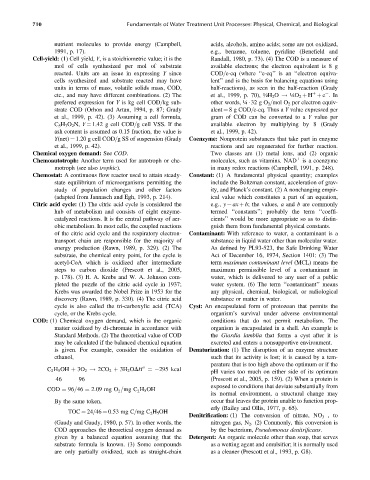Page 755 - Fundamentals of Water Treatment Unit Processes : Physical, Chemical, and Biological
P. 755
710 Fundamentals of Water Treatment Unit Processes: Physical, Chemical, and Biological
nutrient molecules to provide energy (Campbell, acids, alcohols, amino acids; some are not oxidized,
1991, p. 17). e.g., benzene, toluene, pyridine (Benefield and
Cell-yield: (1) Cell yield, Y, is a stoichiometric value; it is the Randall, 1980, p. 73). (4) The COD is a measure of
mol of cells synthesized per mol of substrate available electrons; the electron equivalent is 8 g
reacted. Units are an issue in expressing Y since COD=e-eq (where ‘‘e-eq’’ is an ‘‘electron equiva-
cells synthesized and substrate reacted may have lent’’ and is the basis for balancing equations using
units in terms of mass, volatile solids mass, COD, half-reactions), as seen in the half-reaction (Grady
etc., and may have different combinations. (2) The et al., 1999, p. 70), ½H 2 O ! ¼O 2 þ H þ e .In
þ
preferred expression for Y is kg cell COD=kg sub- other words, ¼ 32 g O 2 =mol O 2 per electron equiv-
strate COD (Orhon and Artan, 1994, p. 87; Grady alent ¼ 8 g COD=e-eq. Thus a Y value expressed per
et al., 1999, p. 42). (3) Assuming a cell formula, gram of COD can be converted to a Y value per
C 5 H 7 O 2 N, Y ¼ 1.42 g cell COD=g cell VSS. If the available electron by multiplying by 8 (Grady
ash content is assumed as 0.15 fraction, the value is et al., 1999, p. 42).
Y(net) ¼ 1.20 g cell COD=g SS of suspension (Grady Coenzyme: Nonprotein substances that take part in enzyme
et al., 1999, p. 42). reactions and are regenerated for further reaction.
Chemical oxygen demand: See COD. Two classes are (1) metal ions, and (2) organic
Chemoautotroph: Another term used for autotroph or che- molecules, such as vitamins. NAD is a coenzyme
þ
motroph (see also trophic). in many redox reactions (Campbell, 1991, p. 248).
Chemostat: A continuous flow reactor used to attain steady- Constant: (1) A fundamental physical quantity; examples
state equilibrium of microorganisms permitting the include the Boltzman constant, acceleration of grav-
study of population changes and other factors ity, and Planck’s constant. (2) A nonchanging empir-
(adapted from Jannasch and Egh, 1993, p. 214). ical value which constitutes a part of an equation,
Citric acid cycle: (1) The citric acid cycle is considered the e.g., y ¼ ax þ b; the values, a and b are commonly
hub of metabolism and consists of eight enzyme- termed ‘‘constants’’; probably the term ‘‘coeffi-
catalyzed reactions. It is the central pathway of aer- cients’’ would be more appropriate so as to distin-
obic metabolism. In most cells, the coupled reactions guish them from fundamental physical constants.
of the citric acid cycle and the respiratory electron- Contaminant: With reference to water, a contaminant is a
transport chain are responsible for the majority of substance in liquid water other than molecular water.
energy production (Rawn, 1989, p. 329). (2) The As defined by PL93-523, the Safe Drinking Water
substrate, the chemical entry point, for the cycle is Act of December 16, 1974, Section 1401: (3) The
acetyl-CoA which is oxidized after intermediate term maximum contaminant level (MCL) means the
steps to carbon dioxide (Prescott et al., 2005, maximum permissible level of a contaminant in
p. 178). (3) H. A. Krebs and W. A. Johnson com- water, which is delivered to any user of a public
pleted the puzzle of the citric acid cycle in 1937; water system. (6) The term ‘‘contaminant’’ means
Krebs was awarded the Nobel Prize in 1953 for the any physical, chemical, biological, or radiological
discovery (Rawn, 1989, p. 330). (4) The citric acid substance or matter in water.
cycle is also called the tri-carboxylic acid (TCA) Cyst: An encapsulated form of protozoan that permits the
cycle, or the Krebs cycle. organism’s survival under adverse environmental
COD: (1) Chemical oxygen demand, which is the organic conditions that do not permit metabolism. The
matter oxidized by di-chromate in accordance with organism is encapsulated in a shell. An example is
Standard Methods. (2) The theoretical value of COD the Giardia lamblia that forms a cyst after it is
may be calculated if the balanced chemical equation excreted and enters a nonsupportive environment.
is given. For example, consider the oxidation of Denaturization: (1) The disruption of an enzyme structure
ethanol, such that its activity is lost; it is caused by a tem-
perature that is too high above the optimum or if the
C 2 H 5 OH þ 3O 2 ! 2CO 2 þ 3H 2 ODH ¼ 295 kcal
pH varies too much on either side of its optimum
46 96 (Prescott et al., 2005, p. 159). (2) When a protein is
exposed to conditions that deviate substantially from
COD ¼ 96=46 ¼ 2:09 mg O =mg C H 5 OH
2
2
its normal environment, a structural change may
By the same token, occur that leaves the protein unable to function prop-
erly (Bailey and Ollis, 1977, p. 65).
TOC ¼ 24=46 ¼ 0.53 mg C=mg C 2 H 5 OH
Denitrification: (1) The conversion of nitrate, NO 3 ,to
(Gaudy and Gaudy, 1980, p. 57). In other words, the nitrogen gas, N 2 . (2) Commonly, this conversion is
COD approaches the theoretical oxygen demand as by the bacterium, Pseudomonas denitrificans.
given by a balanced equation assuming that the Detergent: An organic molecule other than soap, that serves
substrate formula is known. (3) Some compounds as a wetting agent and emulsifier; it is normally used
are only partially oxidized, such as straight-chain as a cleaner (Prescott et al., 1993, p. G8).

